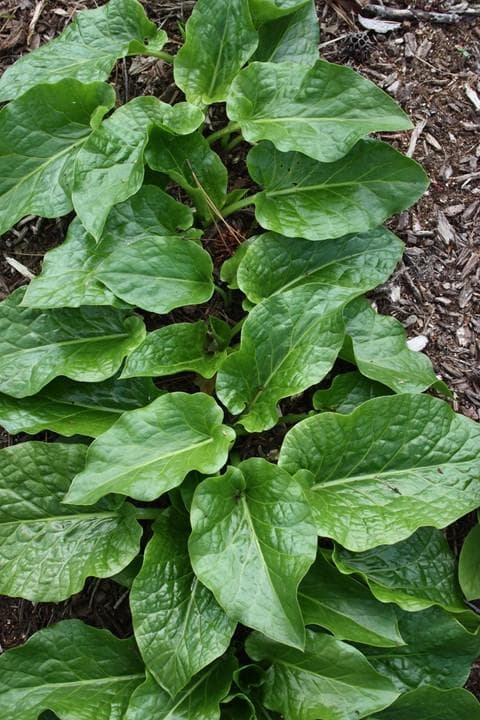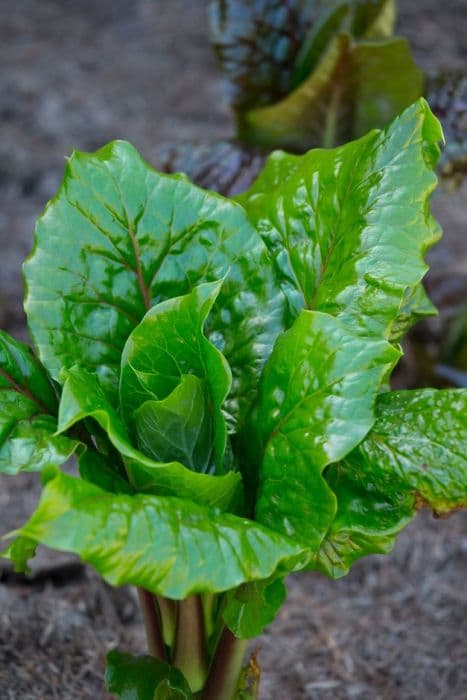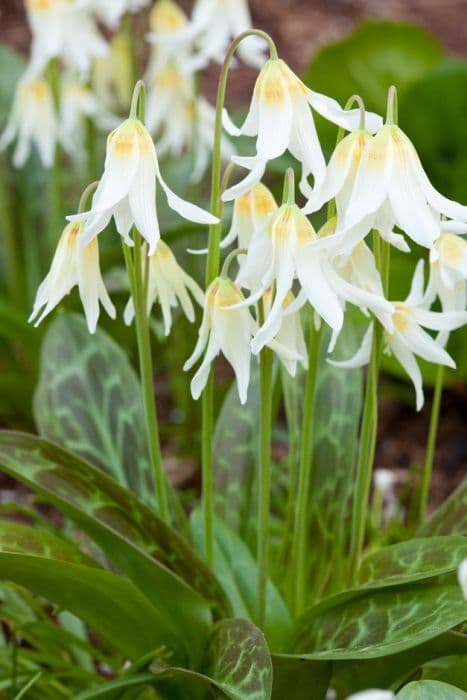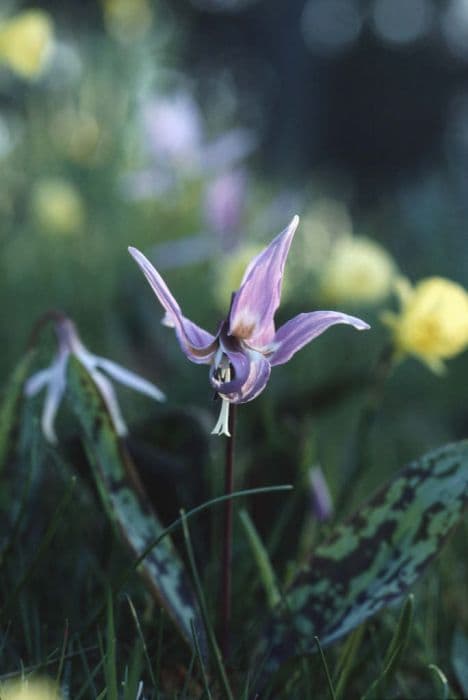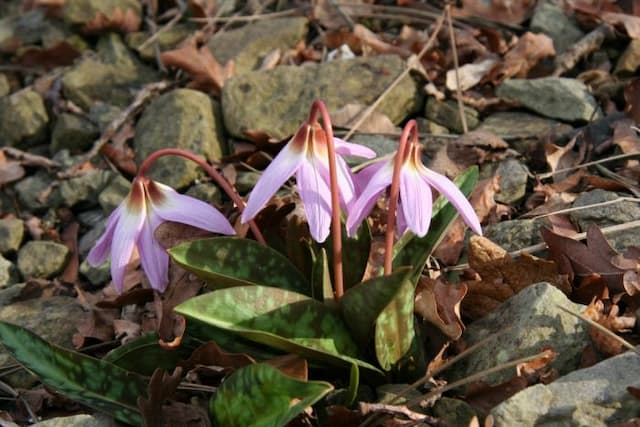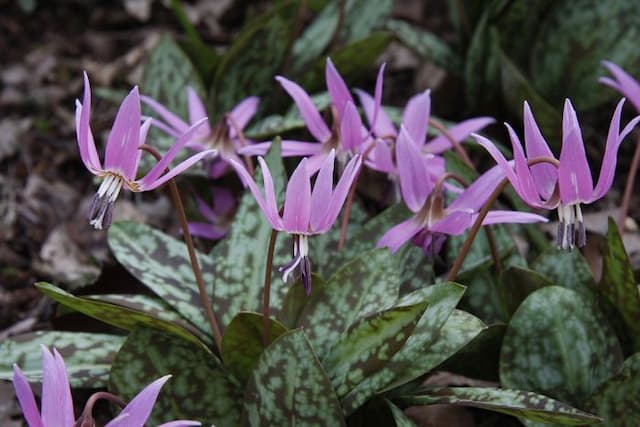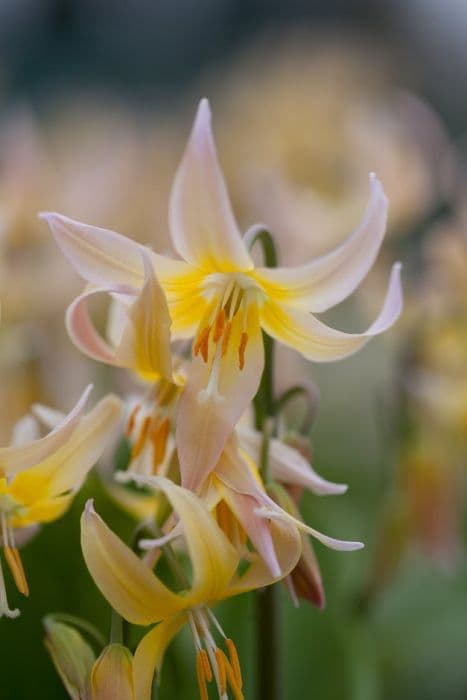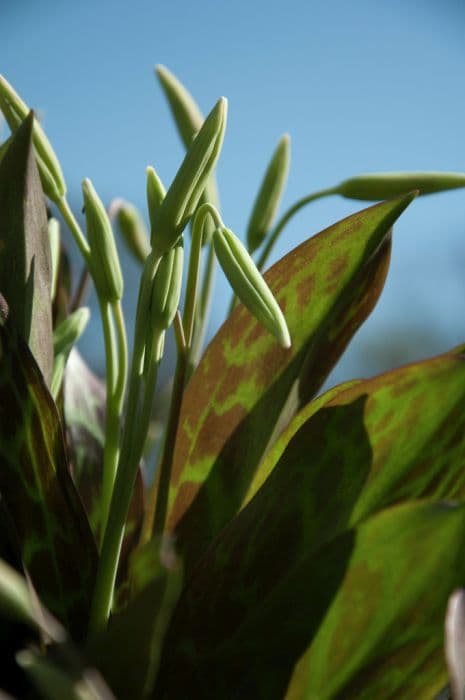Crown Imperial Fritillaria imperialis 'Garland Star'

ABOUT
The Fritillaria imperialis 'Garland Star', commonly known as Crown Imperial, is a striking and unique-looking flowering plant. It is distinguishable by its prominent display of vibrant, bell-shaped flowers, which usually come in bright shades of orange. These flowers form a ring or 'garland' beneath a small pineapple-like tuft of bright green leafy bracts, which gives this plant a regal, crown-like appearance. Each of the pendulous flowers boasts a bold, eye-catching color set against a backdrop of glossy, lance-shaped leaves that spiral up the stem, adding texture and a lush green contrast. The overall look of the Crown Imperial is one of majesty and grandeur, as the flowers hang in a circular cluster. The unique formation of blooms around the top of the stem resembles a royal scepter. While this plant blooms, it emits a musky odor which is not necessarily appealing to humans but serves to repel animals and pests that might otherwise be interested in the striking flowers.
About this plant
 Names
NamesFamily
Liliaceae
Synonyms
Crown Imperial, Imperial Fritillary, Kaiser's Crown
Common names
Fritillaria imperialis 'Garland Star'.
 Toxicity
ToxicityTo humans
The Crown Imperial, while not commonly considered a toxic plant to humans, still warrants some caution. There is little evidence of its toxicity, and it is not typically associated with severe poisoning in people. However, as with many ornamental plants, it is advisable to avoid ingesting any part of the Crown Imperial, as it may cause mild stomach upset or discomfort. It is always best practice to keep all ornamental plants out of the reach of children who might accidentally ingest them.
To pets
The Crown Imperial may pose a risk of toxicity to pets if ingested. The plant contains alkaloids which can be harmful, and eating the bulbs is particularly dangerous, as they contain the highest concentration of these compounds. If a pet consumes any part of this plant, symptoms of poisoning might include vomiting, diarrhea, abdominal pain, and possibly drooling. If you suspect your pet has ingested any part of the Crown Imperial, it is important to contact your veterinarian immediately for advice.
 Characteristics
CharacteristicsLife cycle
Perennials
Foliage type
Deciduous
Color of leaves
Green
Flower color
Orange
Height
3 feet [0.91 meters]
Spread
1 foot [0.30 meters]
Plant type
Bulb
Hardiness zones
5
Native area
Middle East
Benefits
 General Benefits
General Benefits- Aesthetic Appeal: The plant adds a striking visual element to gardens with its tall stem, large bell-shaped flowers, and unique crown of leaves atop the flower cluster.
- Landscape Focal Point: Due to its size and distinctive flowers, it can serve as an excellent focal point in landscape designs.
- Pollinator Attraction: Attracts bees and other pollinators, which are essential for the health of the garden ecosystem.
- Spring Blooming: As a spring-blooming plant, it provides early-season color after the winter months.
- Drought Tolerance: Once established, it has good drought tolerance, making it suitable for xeriscaping and low-water-use gardens.
- Deer and Rodent Resistant: Its unique scent tends to deter deer and rodents, protecting itself and nearby plants from browsing.
- Versatility: Can be used in a variety of gardening situations, including borders, beds, and containers.
- Cut Flower Use: The striking flowers can be used in floral arrangements as cut flowers.
 Medical Properties
Medical Properties- This plant is not used for medical purposes.
 Air-purifying Qualities
Air-purifying QualitiesThis plant is not specifically known for air purifying qualities.
 Other Uses
Other Uses- Fritillaria imperialis 'Garland Star', commonly known as Crown Imperial, can be used as a natural rodent repellent due to its strong, musky odor that is offensive to these pests.
- The pungent scent of Crown Imperial can also deter deer and other herbivores from grazing in gardens where they are planted.
- In the language of flowers, Crown Imperials symbolize power and majesty and can be used in floral arrangements to convey this message.
- The bulbs of the Crown Imperial, when planted strategically, can help protect more vulnerable plants in the garden by keeping burrowing animals at bay.
- The tall and striking appearance of the Crown Imperial can be utilized in landscaping as a focal point in garden design.
- When dried, the seed pods of the Crown Imperial can be used in craft projects or as a unique addition to dried flower arrangements.
- The plant's height and unique flower shape make it an interesting subject for botanical illustration and educational materials.
- Crown Imperial can be used as a teaching tool in horticultural classes, demonstrating bulb planting and care techniques.
- In large public gardens, Crown Imperial can serve as a seasonal marker to indicate the arrival of spring due to its early bloom time.
- Anecdotal evidence suggests that placing Crown Imperial bulbs around fruit trees may discourage rodents from gnawing on the trees.
Interesting Facts
 Feng Shui
Feng ShuiCrown Imperial is not used in Feng Shui practice.
 Zodiac Sign Compitability
Zodiac Sign CompitabilityCrown Imperial is not used in astrology practice.
 Plant Symbolism
Plant Symbolism- Royalty: The name 'imperialis' suggests imperial or regal qualities, and its majestic look often symbolizes high status and power.
- Pride: With its tall, proud stance and crown-like blossoms, it can represent pride or vanity.
- Resilience: As a hardy plant, it can be a symbol of someone's ability to withstand difficult conditions.
- Distinction: The unusual and unique appearance of the flowers makes the plant stand out, symbolizing distinction or uniqueness in a person.
 Water
WaterThe Crown Imperial needs to be watered thoroughly when the soil feels dry to the touch; typically, this might be once a week but depends on climate and soil conditions. During the growing season, ensure you provide enough water to soak the soil to a depth of at least 2 inches. When watering, aim to add approximately half a gallon to a gallon per plant, ensuring even distribution around the bulb's base without waterlogging. Reduce watering after the foliage starts to die back post flowering and cease completely once the bulb is dormant. In areas with wet winters, be cautious not to let the bulbs sit in waterlogged soil which can cause rot.
 Light
LightCrown Imperials thrive in full sunlight to light shade. The ideal spot for this plant is a location where it can receive at least 6 hours of direct sunlight daily, although it can tolerate partial shade, especially in hotter climates. Avoid deep shade as it will hinder bloom and vigorous growth.
 Temperature
TemperatureCrown Imperials prefer temperate climates and can generally withstand winter lows down to about 10 to 15 degrees Fahrenheit, but they flourish best when the temperature is between 50 and 70 degrees Fahrenheit. The maximum temperature for the plant shouldn't exceed 80 degrees Fahrenheit to prevent stress and potential damage to the bulb.
 Pruning
PruningPruning Crown Imperials mainly involves deadheading spent flowers after blooming and cutting back the foliage once it has yellowed and begun to die back. This usually occurs in late spring or early summer. Pruning is needed to prevent the plant from expending energy on seed production and to encourage resources to be directed back to the bulb for next year's growth.
 Cleaning
CleaningAs needed
 Soil
SoilCrown Imperial prefers a soil mix with excellent drainage as it is prone to rot in soggy soil. Mix equal parts of loam, leaf mold, and sharp sand to create a conducive environment. A pH level of around 6.0 to 7.0 is ideal for this plant.
 Repotting
RepottingCrown Imperials do not need to be repotted frequently; doing so every few years is adequate. They should be repotted if the bulbs become overcrowded or if the soil is exhausted.
 Humidity & Misting
Humidity & MistingCrown Imperial thrives best in moderate ambient humidity and does not require any special humidity adjustments when grown outdoors in its suitable climate range.
 Suitable locations
Suitable locationsIndoor
Provide bright, indirect light and cool temps.
Outdoor
Plant in well-drained soil; full sun or partial shade.
Hardiness zone
5-9 USDA
 Life cycle
Life cycleCrown Imperial 'Garland Star' begins its life cycle as a bulb, which is planted in well-draining soil in the fall, just before the onset of winter. During winter, the bulb undergoes a period of dormancy, where it experiences the cold temperatures required for vernalization. In spring, the bulb breaks dormancy and sprouts, with a strong stem rising from the ground and a whorl of leaves and a prominent, bell-shaped cluster of orange to red flowers with a crown of leaves on top emerging from the foliage. After flowering, which usually occurs in mid to late spring, the plant enters the pollination stage, where it may be visited by a variety of insects, especially bees. Once the flowers are pollinated, the plant produces seeds, which then ripen by late summer and can be dispersed for propagation. After seed maturation, the foliage yellows and the plant goes back into dormancy, withdrawing resources back into the bulb to survive the winter and begin the cycle anew the following spring.
 Propogation
PropogationPropogation time
Spring
The most popular method of propagating the Crown Imperial (Fritillaria imperialis 'Garland Star') is through bulb offsets. This plant typically is propagated in the late summer to fall, after the foliage has died back and the bulb is dormant. To propagate by offsets, carefully dig up the bulb and gently separate the smaller bulblets that form around the base of the mother bulb. Each offset must have a portion of the base plate to grow into a new plant. Replant the offsets immediately at a depth of about 6 to 8 inches (15 to 20 centimeters) to ensure they establish before the winter. It is crucial to provide well-drained soil and to not plant in an area where water collects to prevent rot. These offsets will grow and usually flower after two to three years.
